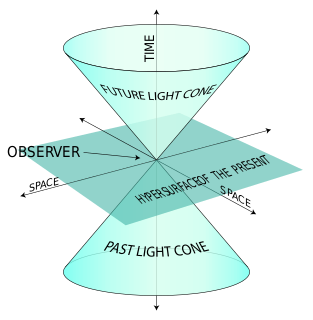
Faster-than-light communications and travel are the conjectural propagation of information or matter faster than the speed of light. The special theory of relativity implies that only particles with zero rest mass may travel at the speed of light, and that nothing may travel faster.
The technology in Star Trek has borrowed many ideas from the scientific world. Episodes often contain technologies named after real-world scientific phenomena, such as tachyon beams, baryon sweeps, quantum slipstream drives, and photon torpedoes. Some of the technologies created for the Star Trek universe were done so out of financial necessity. For instance, the transporter was created because the limited budget of Star Trek: The Original Series (TOS) in the 1960s did not allow expensive shots of spaceships landing on planets.

The speed of light, or lightspeed, in vacuum, commonly denoted c, is a universal physical constant important in many areas of physics. Its exact value is defined as 299792458 metres per second. It is exact because, by international agreement, a metre is defined as the length of the path travelled by light in vacuum during a time interval of 1⁄299792458 second. According to special relativity, c is the upper limit for the speed at which conventional matter, energy or any signal carrying information can travel through space. A light-year is a distance unit, defined as the distance travelled by light in one Julian year.
Superluminal communication is a hypothetical process in which information is sent at faster-than-light (FTL) speeds. The current scientific consensus is that faster-than-light communication is not possible, and to date it has not been achieved in any experiment.

The Alcubierre drive, Alcubierre warp drive, or Alcubierre metric is a speculative warp drive idea based on a solution of Einstein's field equations in general relativity as proposed by theoretical physicist Miguel Alcubierre during his PhD study at the University of Wales, Cardiff, by which a spacecraft could achieve apparent faster-than-light travel if a configurable energy-density field lower than that of vacuum could be created.

A warp drive or a drive enabling space warp is a fictional superluminal spacecraft propulsion system in many science fiction works, most notably Star Trek, and a subject of ongoing physics research. The general concept of "warp drive" was introduced by John W. Campbell in his 1957 novel Islands of Space and was popularized by the Star Trek series. It's based on the Alcubierre drive, a theoretical solution of the field equations of the General theory of relativity.
A starship, starcraft, or interstellar spacecraft is a theoretical spacecraft designed for traveling between planetary systems.
Galactic empires are a common trope used in science fantasy and science fiction, particularly in works known as 'space operas'. Many authors have either used a galaxy-spanning empire as background or written about the growth and/or decline of such an empire. The capital of a galactic empire is frequently a core world, such as a planet relatively close to a galaxy's supermassive black hole, which has advanced considerably in science and technology compared to current human civilization. Characterizations can vary wildly from malevolent forces attacking sympathetic victims to apathetic bureaucracies to more reasonable entities focused on social progress and anywhere in between.

The Spacing Guild is an organization in Frank Herbert's science fiction Dune universe. With its monopoly on interstellar travel and banking, the power of the Guild is balanced against that of the Padishah Emperor as well as of the assembled noble Houses of the Landsraad. Mutated Guild Navigators use the spice drug melange to achieve limited prescience, allowing them to successfully navigate "folded space" and safely guide enormous heighliner starships from planet to planet instantaneously. Essentially apolitical, the Guild is primarily concerned with the flow of commerce and preservation of the economy that supports them; although their ability to dictate the terms of and fees for all transport gives them influence in the political arena, they do not pursue political goals beyond their economic ones. It is noted in Dune (1965) that Houses of the Imperium may contract with the Guild to be removed "to a place of safety outside the System"; in the past, some Houses in danger of ruin or defeat have "become renegade Houses, taking family atomics and shields and fleeing beyond the Imperium". The Guild controls a "sanctuary planet" known as Tupile intended for such "defeated Houses of the Imperium ... Location(s) known only to the Guild and maintained inviolate under the Guild Peace".

A Guild Navigator is a fictional humanoid in the Dune universe created by Frank Herbert. In this series and its derivative works, starships called heighliners employ a scientific phenomenon known as the Holtzman effect to "fold space" and thereby travel great distances across the universe instantaneously. Humans mutated through the consumption of and exposure to massive amounts of the spice melange, Navigators are able to use a limited form of prescience to safely navigate interstellar space. Control of these Navigators gives the Spacing Guild its monopoly on interstellar travel and banking, making the organization a balance of power against the Padishah Emperor and the assembled noble Houses of the Landsraad.

In special and general relativity, a light cone is the path that a flash of light, emanating from a single event and traveling in all directions, would take through spacetime.

Intergalactic travel is the hypothetical crewed or uncrewed travel between galaxies. Due to the enormous distances between the Milky Way and even its closest neighbors—tens of thousands to millions of light-years—any such venture would be far more technologically demanding than even interstellar travel. Intergalactic distances are roughly a hundred-thousandfold greater than their interstellar counterparts.
Hyperspace is a concept from science fiction and cutting-edge science relating to higher dimensions and a superluminal method of interstellar travel. It is related to the concept of four-dimensional space, first described in the 19th century.
In science fiction, ultrawaves are transmissions or signals that may propagate faster than light through either normal space, or alternate space, such as hyperspace or subspace.

The hypothetical particles tachyons have inspired many occurrences of in fiction. The use of the word in science fiction dates back at least to 1970 when James Blish's Star Trek novel Spock Must Die! incorporated tachyons into an ill-fated transporter experiment.
The inertialess drive is a fictional means of accelerating to close to the speed of light or faster-than-light travel, originally used in Triplanetary and the Lensman series by E.E. "Doc" Smith, and later by Robert A. Heinlein, Arthur C. Clarke, Larry Niven, Julian May and Alastair Reynolds.
Negative energy is a concept used in physics to explain the nature of certain fields, including the gravitational field and various quantum field effects.

Space travel or space flight is a major classic theme in science fiction, one that has generally captured the attention of the public and is commonly associated with the typical image of a science fiction plot. Space travel, whether interplanetary or interstellar, is usually carried out through space ships, and methods of spacecraft propulsion described in various works range from scientifically plausible to totally fictitious. While some writers focus on the realistic, scientific and educational aspects of space travel, for others, that concept can be seen as a metaphor for freedom, one of whose aspects is to "free mankind from the prison of the solar system". Although the concept of a rocket, popularized by the science fiction works, has been described as one of the icons of the 20th century, according to The Encyclopedia of Science Fiction, "The means by which space flight has been achieved in sf – its many and various spaceships – have always been of secondary importance to the mythical impact of the theme".









